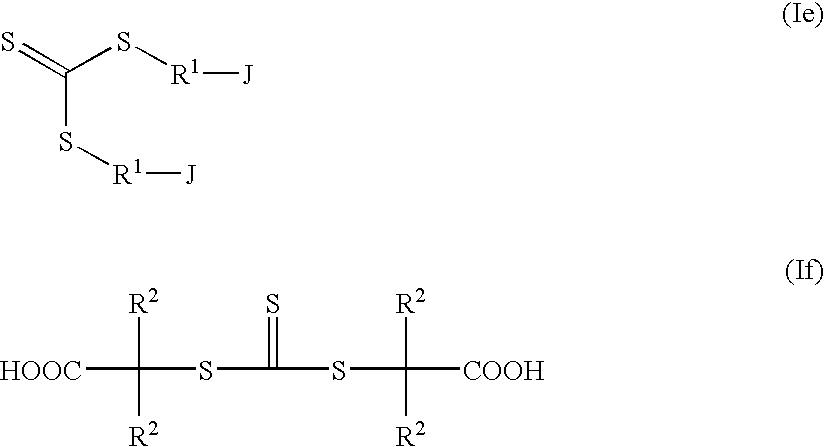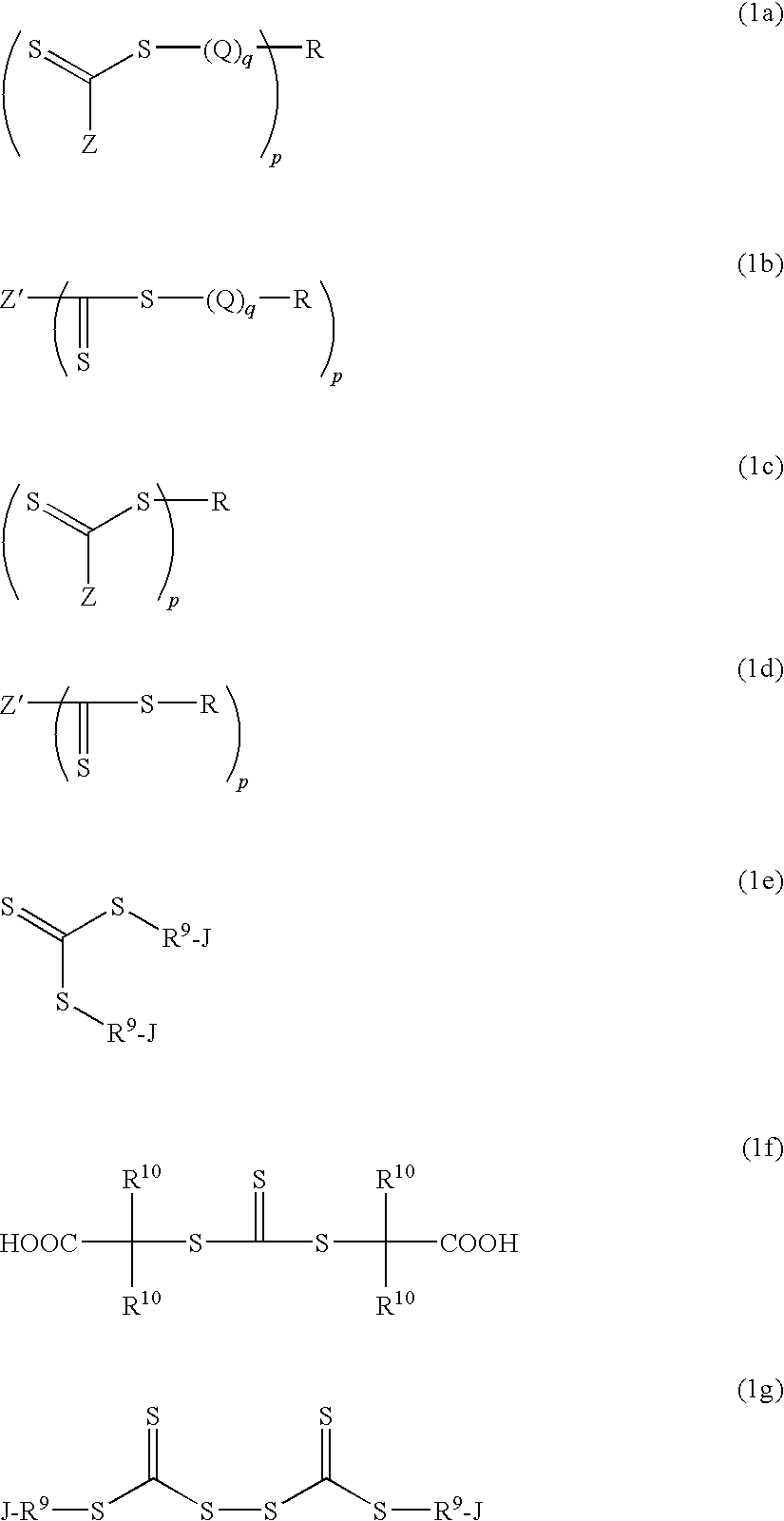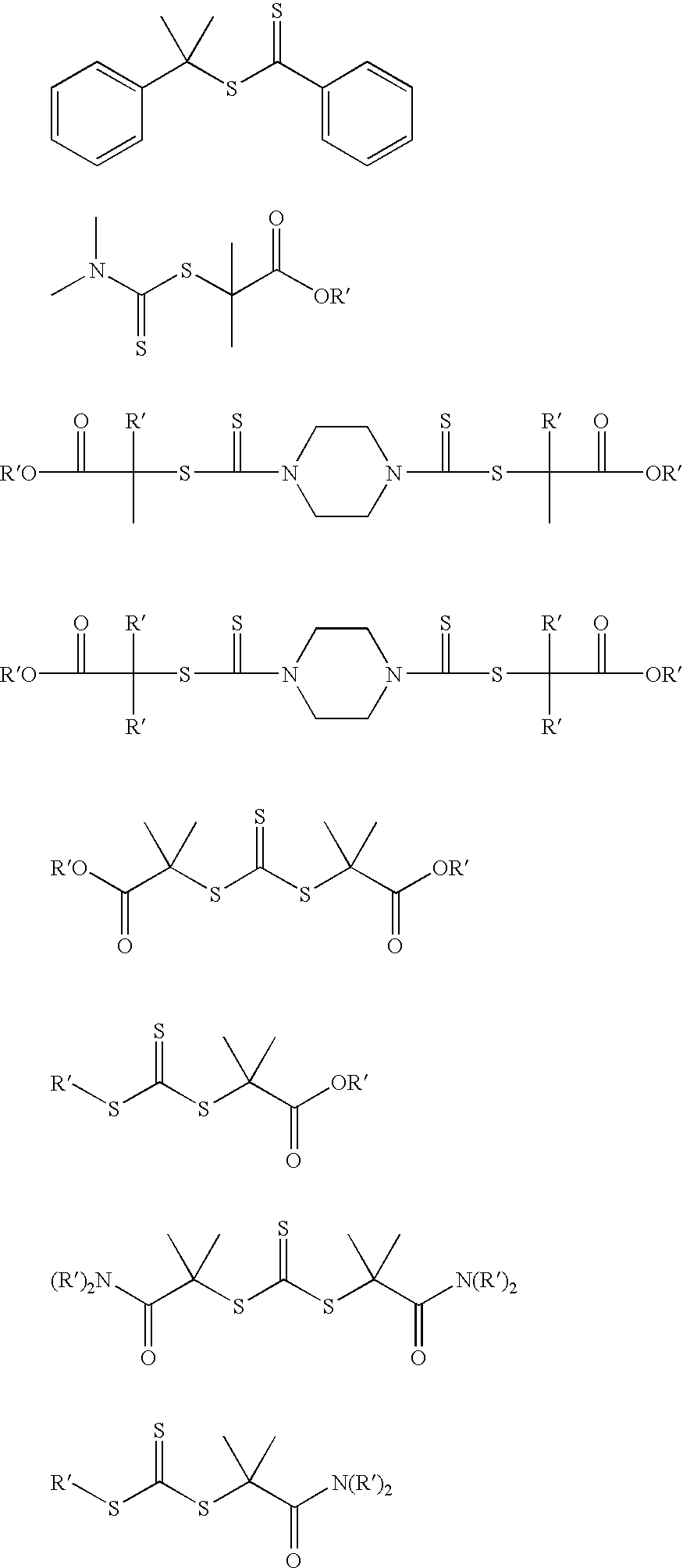Process for Preparing Polymers and Compositions Thereof
- Summary
- Abstract
- Description
- Claims
- Application Information
AI Technical Summary
Problems solved by technology
Method used
Image
Examples
examples 1-16
Narrow Polydispersity Linear PMAS by RAFT Polymerisation
[0156]A series of PMAs (polymethacrylates) of different weight average molecular weight (Mw) and monomer compositions are prepared by varying the amount of initiator and chain transfer agent according to the formula Mw=g of monomer / (moles of initiator+moles CTA). Monomers, Trigonox™-21 (initiator), CTA (Chain Transfer Agent) and oil (30% wt) are combined at room temperature in a vessel equipped with a nitrogen inlet flowing at 28.3 L / hr, medium speed mechanical stirrer, a thermocouple and a water-cooled condenser and stirred under N2 blanket for 20 minutes to ensure mixing. The nitrogen flow is reduced to 14.2 L / hr and the mixture is set to be heated to 90° C. for 4 hrs. The results obtained for weight average molecular weight (Mw), number average molecular weight (Mn) and the polydispersity (PDI) as measured by gel permeation chromatography (GPC) are shown in Table 1:
TABLE 1GPCEXVM DescriptionCTARatio*MnMwPDI1C12-15MA / 2-EHMACD...
examples 17-22
Narrow Polydispersity Linear Block / Tapered Copolymers by RAFT Polymerisation
[0157]A series of block copolymers with varying monomer composition within the blocks and different overall molecular weights are prepared by a process similar to that of examples 1-16 except the monomers are added in two portions, where the second monomer portion also contains an additional small amount (˜10 wt % of the initial charge) of the free radical initiator (see Table 2). In examples 17-19, the first portion contains C12-15MA and this is allowed to polymerise for 4 hrs before the second monomer is added to allow the formation of block / tapered copolymer. In examples 20-21, the first portion contains a mixture of C12-15MA and 2-EHMA, polymerisation of which forms a random first block. Addition of styrene as a second monomer portion leads to the formation of block / tapered copolymer. Example 22 is prepared in similar manner to examples 20-21, except the first portion of monomer is a mixture of C12-15MA ...
examples 23-36
Random Star Copolymer of a Polymethacrylate Coupled with DVB
[0158]A series of polymethacrylate stars of different overall molecular weight are prepared by varying the amount of initiator and divinyl benzene (DVB) as shown in the Table 3 below. C12-15 methacrylate (70% wt), 2 ethylhexyl methacrylate (30% wt), Trigonox™-21 (1 eq), cumyl dithiobenzoate (2 eq) and oil (26% wt) are combined at room temperature in a vessel equipped with a nitrogen inlet flowing at 28.3 L / hr, medium speed mechanical stirrer, a thermocouple and a water-cooled condenser and are stirred under N2 blanket for 20 minutes to ensure mixing. The nitrogen flow is reduced to 14.2 L / hr and the mixture is set to be heated to 90° C. for 4 hrs. DVB is charged to the reaction flask and the mixture is stirred at 90° C. for a maximum of 12 hours. The results obtained for weight average molecular weight (Mw), number average molecular weight (Mn), the polydispersity, the number of arms on the star polymer and the percentage c...
PUM
| Property | Measurement | Unit |
|---|---|---|
| Fraction | aaaaa | aaaaa |
| Fraction | aaaaa | aaaaa |
| Fraction | aaaaa | aaaaa |
Abstract
Description
Claims
Application Information
 Login to View More
Login to View More - R&D
- Intellectual Property
- Life Sciences
- Materials
- Tech Scout
- Unparalleled Data Quality
- Higher Quality Content
- 60% Fewer Hallucinations
Browse by: Latest US Patents, China's latest patents, Technical Efficacy Thesaurus, Application Domain, Technology Topic, Popular Technical Reports.
© 2025 PatSnap. All rights reserved.Legal|Privacy policy|Modern Slavery Act Transparency Statement|Sitemap|About US| Contact US: help@patsnap.com



